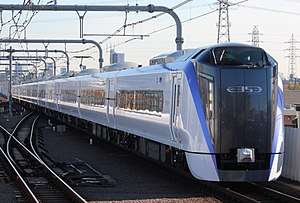Fuji Excursion
The Fuji Excursion (富士回遊, Fuji Kaiyū)[1] is a regular limited express service operated by East Japan Railway Company (JR East) and Fuji Kyuko, between Shinjuku on the Chūō Line and Kawaguchiko on the Fujikyuko Line.
 The rolling stock for the Fuji Excursion, E353 series | |
| Overview | |
|---|---|
| Service type | Limited express |
| Status | In service |
| Locale | Tokyo, Kanagawa Prefecture, Yamanashi Prefecture |
| First service | 16 March 2019 |
| Current operator(s) | East Japan Railway Company (JR East) Fuji Kyuko |
| Route | |
| Start | Shinjuku Station |
| End | Kawaguchiko Station |
| Line(s) used | JR East: Chūō Main Line Fuji Kyuko: Fujikyuko Line |
| On-board services | |
| Class(es) | Standard class only |
| Technical | |
| Rolling stock | E353 series EMUs |
| Track gauge | 1,067 mm (3 ft 6 in) |
| Electrification | 1500 V DC overhead |
| Operating speed | 130 km/h (81 mph) (on Chūō Line) 60 km/h (37 mph) (on Fujikyuko Line) |
Summary
Services begins operation with the implementation on the timetable revision on 16 March 2019.[2] It is the first routinely operated limited express between JR and Fuji Kyuko.
Service pattern
Two round trips are operated per day, and these services are coupled with Kaiji services (with the same train number) between Ōtsuki and Shinjuku.
Stops
(Chiba → Funabashi → Kinshichō → ) Shinjuku - Tachikawa - Hachiōji - Ōtsuki - Tsuru-bunkadaigaku-mae - Shimoyoshida - Mt. Fuji - Fujikyu-Highland - Kawaguchiko
Rolling stock
All services are operated by E353 series 3-car sets, numbered 1 to 3, with car 1 at the Shinjuku end. Between Ōtsuki and Shinjuku, the train will couple with the Kaiji, which is numbered cars 4 to 12.
| Car No. | 1 | 2 | 3 |
|---|---|---|---|
| Numbering | KuMoHa E353-0 | MoHa E353-1000 | KuMoHa E352-0 |
| Accommodation | Reserved | Reserved | Reserved |
| Facilities | Toilet | Toilet |
Ticketing
A limited express ticket has to be purchased to board the Fuji Excursion train, along with the basic fare ticket. There are two types of such limited express tickets, namely the Reserved Seat Ticket (座席指定券, Zaseki shitei ken), and the Unreserved Seat Ticket (座席未指定券, Zaseki mishitei ken).
The Reserved Seat Ticket enables a specified seat to be reserved for the holder. The reserved status for the seat is signified by a green overhead lamp on top of the corresponding seat.
The Unreserved Seat Ticket enables the holder to be seated on any unreserved seat. A red overhead lamp signifies that the seat is unreserved; while a yellow overhead lamp signifies that the seat is reserved for the later part of the journey, implying that one has to give up their seat to the passenger who has reserved the seat, when they board the train later.
Passengers holding the Japan Rail Pass may ride free of charge between Shinjuku and Ōtsuki station. A supplementary ticket is needed to travel further than Otsuki, as the line is no longer operated by JR East. Ticket for this section can be purchased in advance at stations from Fuji-kyuko, or on the train. JR East can not sell tickets and reservations that contains only the section of Fuji-kyuko.
History
- 14 December 2018: Service announced
- 16 March 2019: Service begins
See also
- List of named passenger trains of Japan
- Kaiji, another limited express service that the Fuji Excursion would couple with
References
This article incorporates material from the corresponding article in the Japanese Wikipedia.
- 【お知らせ】中央線直通特急「富士回遊(FUJI EXCURSION)」の運行について [[Information] Regarding the operations of the Chūō Line limited express "Fuji Excursion"] (PDF). Fuji Kyuko. 2018-12-14. Retrieved 2018-12-15.
- 2019年3月ダイヤ改正について(多摩版) [Regarding the timetable revision of March 2019 (Tama Edition)] (PDF). East Japan Railway Company, Hachioji Branch. 2018-12-14. Retrieved 2018-12-14.
.svg.png)